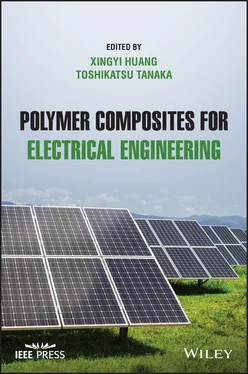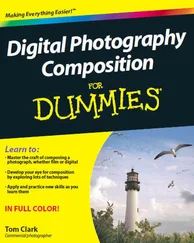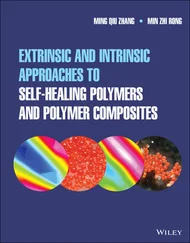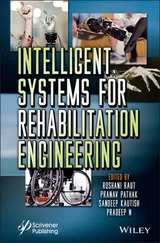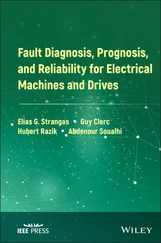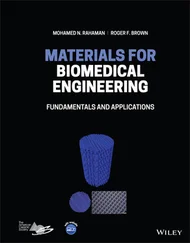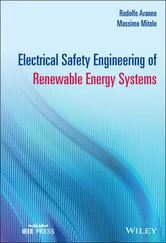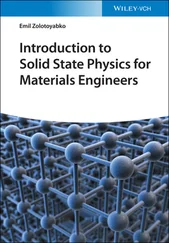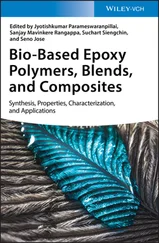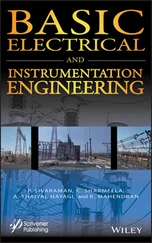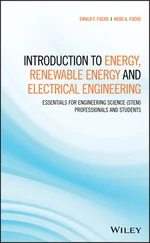Polymer Composites for Electrical Engineering
Здесь есть возможность читать онлайн «Polymer Composites for Electrical Engineering» — ознакомительный отрывок электронной книги совершенно бесплатно, а после прочтения отрывка купить полную версию. В некоторых случаях можно слушать аудио, скачать через торрент в формате fb2 и присутствует краткое содержание. Жанр: unrecognised, на английском языке. Описание произведения, (предисловие) а так же отзывы посетителей доступны на портале библиотеки ЛибКат.
- Название:Polymer Composites for Electrical Engineering
- Автор:
- Жанр:
- Год:неизвестен
- ISBN:нет данных
- Рейтинг книги:5 / 5. Голосов: 1
-
Избранное:Добавить в избранное
- Отзывы:
-
Ваша оценка:
- 100
- 1
- 2
- 3
- 4
- 5
Polymer Composites for Electrical Engineering: краткое содержание, описание и аннотация
Предлагаем к чтению аннотацию, описание, краткое содержание или предисловие (зависит от того, что написал сам автор книги «Polymer Composites for Electrical Engineering»). Если вы не нашли необходимую информацию о книге — напишите в комментариях, мы постараемся отыскать её.
Polymer Composites for Electrical Engineering
Polymer Composites for Electrical Engineering
Polymer Composites for Electrical Engineering — читать онлайн ознакомительный отрывок
Ниже представлен текст книги, разбитый по страницам. Система сохранения места последней прочитанной страницы, позволяет с удобством читать онлайн бесплатно книгу «Polymer Composites for Electrical Engineering», без необходимости каждый раз заново искать на чём Вы остановились. Поставьте закладку, и сможете в любой момент перейти на страницу, на которой закончили чтение.
Интервал:
Закладка:
Table of Contents
1 Cover
2 Title Page
3 Copyright Page
4 List of Contributors
5 Preface
6 1 Polymer Composites for Electrical Energy Storage 1.1 Introduction 1.2 General Considerations 1.3 Effect of Nanofiller Dimension 1.4 Orientation of Nanofillers 1.5 Surface Modification of Nanofillers 1.6 Polymer Composites with Multiple Nanofillers 1.7 Multilayer‐structured Polymer Composites 1.8 Conclusion References
7 2 Polymer Composites for Thermal Energy Storage 2.1 Introduction 2.2 Shape‐stabilized Polymeric Phase Change Composites 2.3 Thermally Conductive Polymeric Phase Change Composites 2.4 Energy Conversion and Storage Based on Polymeric Phase Change Composites 2.5 Emerging Applications of Polymeric Phase Change Composites 2.6 Conclusions and Outlook Acknowledgments References
8 3 Polymer Composites for High‐Temperature Applications 3.1 Applications of Polymer Composite Materials in High‐Temperature Electrical Insulation 3.2 High‐Temperature Applications for Electrical Energy Storage 3.3 Applications of High‐Temperature Polymer in Electronic Packaging 3.4 Applications of Polymer Composite Materials in the Field of High‐Temperature Wave‐Transmitting and Wave‐Absorbing Electrical Fields 3.5 Summary References
9 4 Fire‐Retardant Polymer Composites forElectrical Engineering 4.1 Introduction 4.2 Fire‐Retardant Cables and Wires 4.3 Fire‐Retardant Polymer Composites for Electrical Equipment 4.4 Fire‐Retardant Fiber Reinforced Polymer Composites 4.5 Conclusion and Outlook References
10 5 Polymer Composites for Power Cable Insulation 5.1 Introduction 5.2 Trend in Nanocomposite Materials for Cable Insulation 5.3 Factors Influencing Properties 5.4 Issues in Nanocomposite Insulation Materials Research 5.5 Understanding Dielectric and Insulation Phenomena References
11 6 Semi‐conductive Polymer Composites for Power Cables 6.1 Introduction 6.2 Conductive Mechanism of Semi‐conductive Polymer Composites 6.3 Effect of Polymer Matrix on Semi‐conductivity 6.4 Effect of Conductive Fillers on Semi‐conductivity 6.5 Effect of Semi‐conductive Composites on Space Charge Injection 6.6 Conclusions References
12 7 Polymer Composites for Electric Stress Control 7.1 Introduction 7.2 Functionally Graded Solid Insulators and Their Effect on Reducing Electric Field Stress 7.3 Practical Application of ε‐FGMs to GIS Spacer 7.4 Application to Power Apparatus References
13 8 Composite Materials Used in Outdoor Insulation 8.1 Introduction 8.2 Overview of SIR Materials 8.3 New External Insulation Materials 8.4 Summary References
14 9 Polymer Composites for Embedded Capacitors 9.1 Introduction 9.2 Researches on the Polymer‐Based Dielectric Nanocomposites 9.3 Fabrication Process of Embedded Capacitors 9.4 Reliability Test of Embedded Capacitor Materials 9.5 Conclusions and Perspectives References
15 10 Polymer Composites for Generators and Motors 10.1 Introduction 10.2 Polymer Composite in High‐Voltage Rotating Machines 10.3 Ground Wall Insulation 10.4 Polymer Nanocomposite for Rotating Machine 10.5 Stress‐Grading System of Rotating Machines References
16 11 Polymer Composite Conductors and Lightning Damage 11.1 Lightning Environment and Lightning Damage Threat to Composite‐Based Aircraft 11.2 The Dynamic Conductive Characteristics of CFRP 11.3 The Lightning Strike‐Induced Damage of CFRP Strike 11.4 The Simulation of Lightning Strike‐Induced Damage of CFRP References
17 12 Polymer Composites for Switchgears 12.1 Introduction 12.2 History of Switchgear 12.3 Typical Insulators in Switchgears 12.4 Materials for Epoxy‐based Composites 12.5 Properties of Epoxy‐based Composites 12.6 Advances of Epoxy‐based Composites for Switchgear 12.7 Conclusion References
18 13 Glass Fiber‐Reinforced Polymer Compositesfor Power Equipment 13.1 Overview 13.2 Glass Fiber‐Reinforced Polymer Composites 13.3 Application of Glass Fiber‐Reinforced Polymer Composites References
19 Index
20 End User License Agreement
List of Tables
1 Chapter 2 Table 2.1 The features of ideal PCMs feasible for TES. Table 2.2 Advantages and disadvantages of organic PCMs and inorganic PCMs. Table 2.3 Thermal conductivities of frequently used organic PCMs and therma... Table 2.4 Thermal conductivity of polymeric phase change composites.
2 Chapter 3Table 3.1 The chemical structure and properties of PI derived from molecula...Table 3.2 Performance of fluorine‐containing PI.Table 3.3 Performance of triptycene‐containing polymer.Table 3.4 Dielectric properties of the NH 2‐POSS/PEEK‐CF 3‐COOH composite fil...Table 3.5 Thermal properties of the NH 2‐POSS/PEEK‐CF 3‐COOH composite films....Table 3.6 Properties of the typically reinforced fibers.
3 Chapter 4Table 4.1 The general fire tests for electrical engineering polymeric compo...Table 4.2 Basic mechanical and flammability parameters of polymer matrices.Table 4.3 Synergistic effect of EVA/APP composites.Table 4.4 Basic combustion profiles of polymeric composites of electrical e...
4 Chapter 5Table 5.1 Technical trend of insulation materials for power cable.Table 5.2 List of books and reviews about nanocomposites.Table 5.3 Typical properties of polyethylene and polypropylene.Table 5.4 Properties of metal oxides and nitrides.Table 5.5 Properties of nanocarbons.Table 5.6 Reference list of LDPE and XLPE nanocomposites.Table 5.7 Reference list of polypropylene nanocomposites.Table 5.8 Reference list of polyolefin‐polyhedral oligomeric silsesquioxane...Table 5.9 Reference list of polyolefin blend composites and copolymers.
5 Chapter 8Table 8.1 Performance comparison of different insulation material types.Table 8.2 Comparison of the main specifications of three types of SIR.
6 Chapter 9Table 9.1 Commercially embedded capacitors and their dielectric properties.Table 9.2 Contents of each component in the BT‐Cu/PVDF composites and dielec...Table 9.3 Summary on rubber/epoxy composites.Table 9.4 Mechanical properties of DGEBA/IPDA with different content of nano...
7 Chapter 10Table 10.1 Maximum agglomerate size and volume % of TiO 2nanofiller of the s...
8 Chapter 11Table 11.1 Application of lightning environment to aircraft zones.Table 11.2 The parameters of CFRP specimens.Table 11.3 The parameters of the modulated components corresponding to diffe...Table 11.4 Waveform parameters and the corresponding lightning damage of spe...Table 11.5 The material properties of test CFRP laminates.Table 11.6 The applied lightning components in different test modes and corr...Table 11.7 The parameters of lightning component waveforms in different test...Table 11.8 Lightning damage areas ( S d) and damage depths ( D d) of the CFRP sp...Table 11.9 The current amplitude I pand the corresponding damage depths D d.Table 11.10 The contributing percentages of lightning components to the ligh...Table 11.11 The current electrical action integral W and the corresponding da...Table 11.12 The contributing percentages of the lightning components to the ...
9 Chapter 12Table 12.1 Insulation materials used in switchgear and transformers.Table 12.2 Characteristics of silica and alumina fillers.Table 12.3 Silane coupling agents for epoxy resins.Table 12.4 Limits of temperature and temperature rise for part, materials, a...Table 12.5 Thermal properties of cured epoxy resin by typical acid anhydride...Table 12.6 Coefficients of thermal expansion (CTE) of epoxy‐based composites...Table 12.7 International standards for materials including epoxy‐based compo...Table 12.8 Comparison of epoxidized linseed oil‐based composites.
10 Chapter 13Table 13.1 Types of glass fiber.Table 13.2 Chemical compositions of glass fibers in wt%.Table 13.3 Physical and mechanical properties of glass fiber.Table 13.4 Properties of glass fiber.Table 13.5 Typical cured epoxy/glass mechanical properties.Table 13.6 Basic strand fiber designations and strand counts.Table 13.7 Characteristics of epoxy resins.Table 13.8 Types of industrial rigid laminated sheets based on epoxy resins.Table 13.9 Property requirements of industrial rigid EPGC‐ and EPGM‐laminate...Table 13.10 Types of industrial round rolled tubes.Table 13.11 Property requirements for round rolled tubes.Table 13.12 Property of GFRP pipe for 1100 kV AC composite hollow insulators...Table 13.13 Recommended specification of insulated pull rod for GIS below 55...Table 13.14 Recommended specification of insulated pull rod for GIS above 55...
Читать дальшеИнтервал:
Закладка:
Похожие книги на «Polymer Composites for Electrical Engineering»
Представляем Вашему вниманию похожие книги на «Polymer Composites for Electrical Engineering» списком для выбора. Мы отобрали схожую по названию и смыслу литературу в надежде предоставить читателям больше вариантов отыскать новые, интересные, ещё непрочитанные произведения.
Обсуждение, отзывы о книге «Polymer Composites for Electrical Engineering» и просто собственные мнения читателей. Оставьте ваши комментарии, напишите, что Вы думаете о произведении, его смысле или главных героях. Укажите что конкретно понравилось, а что нет, и почему Вы так считаете.
